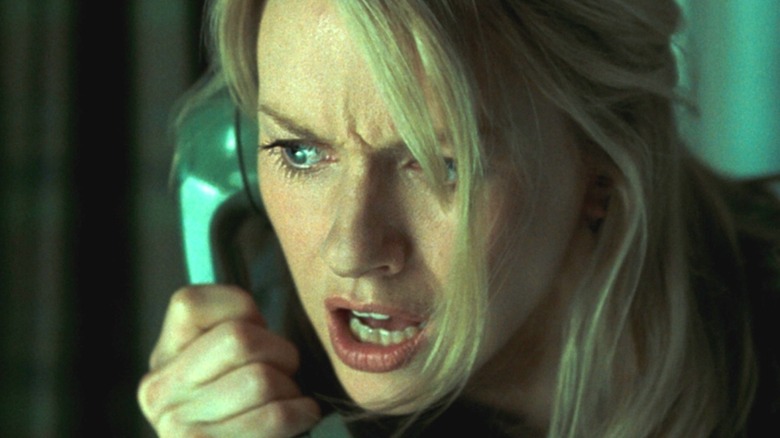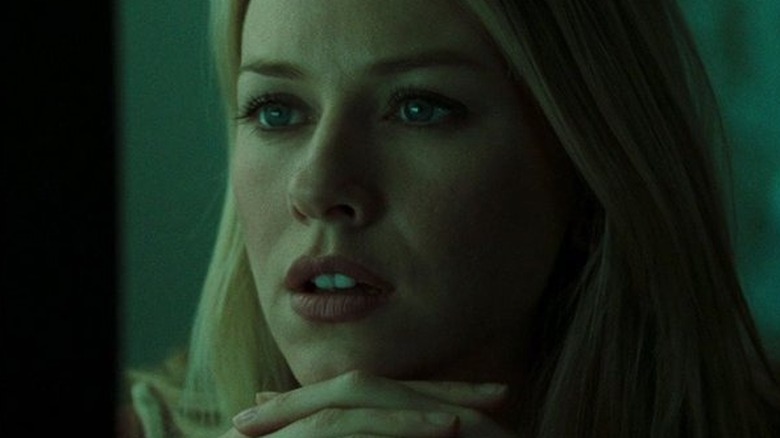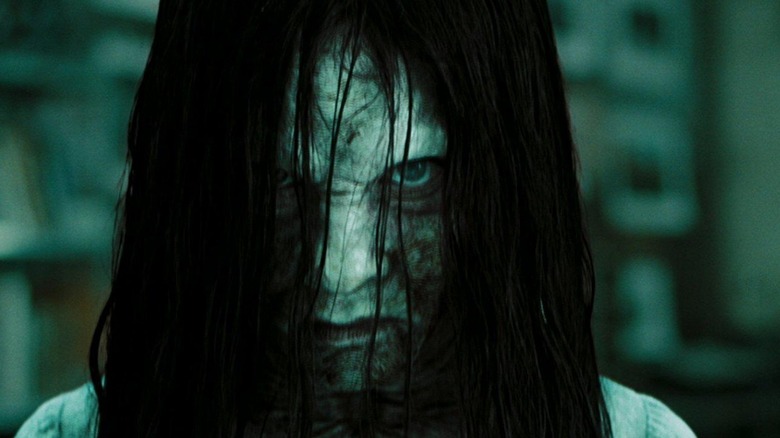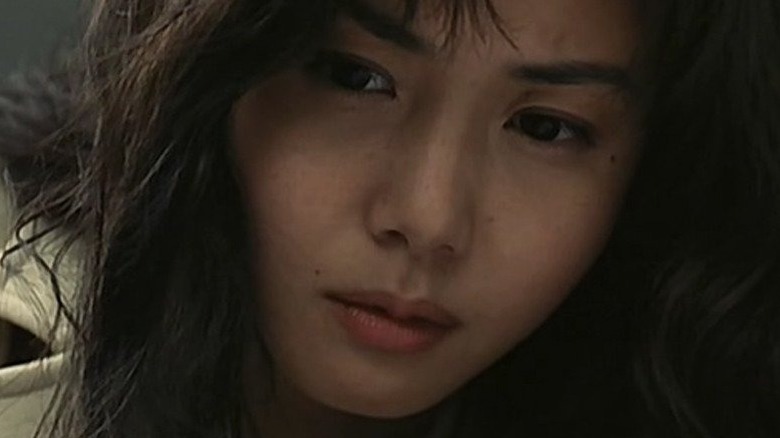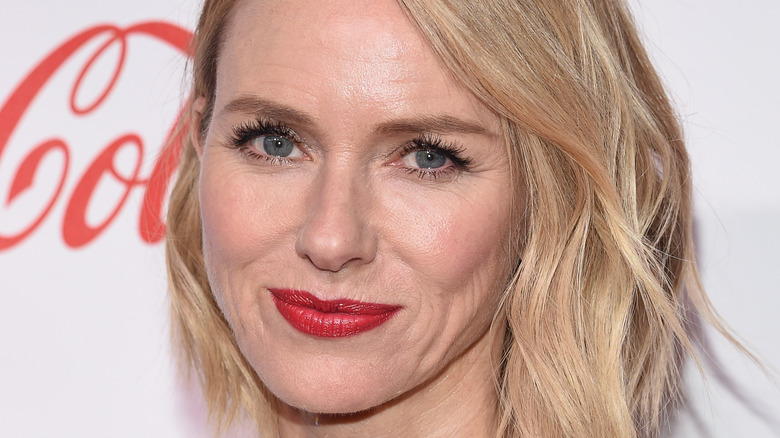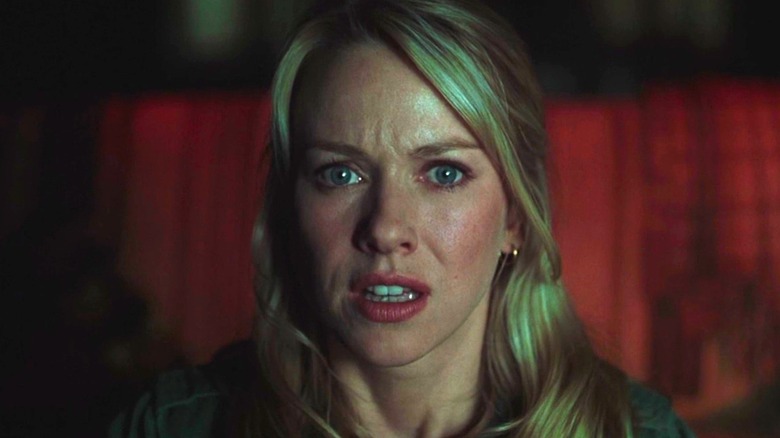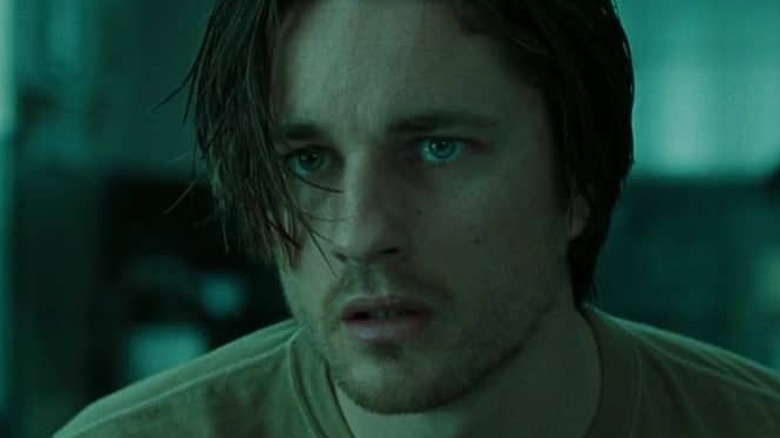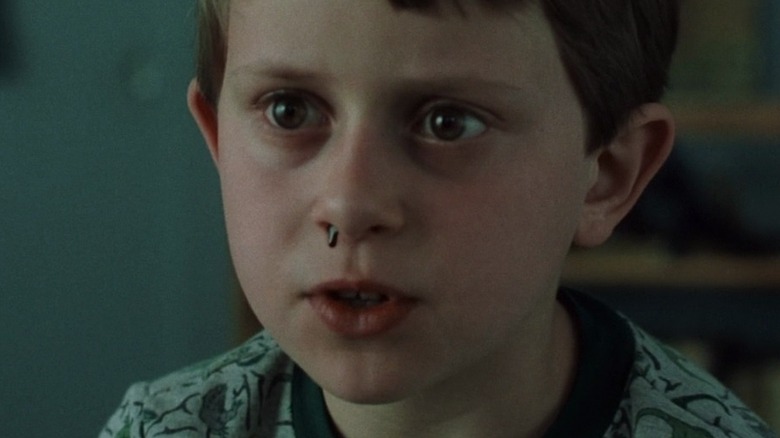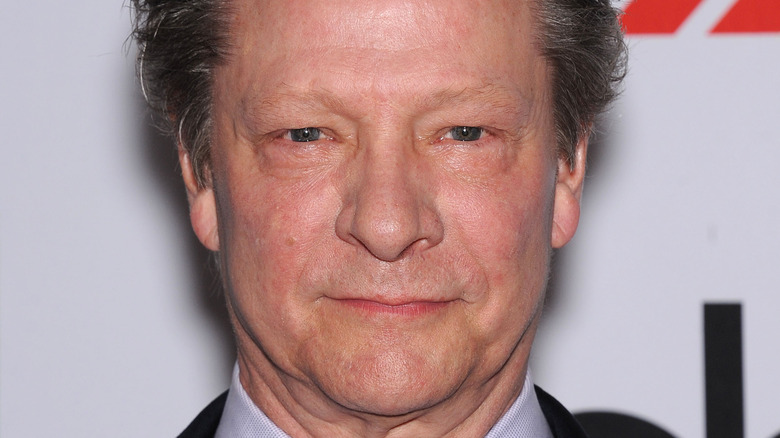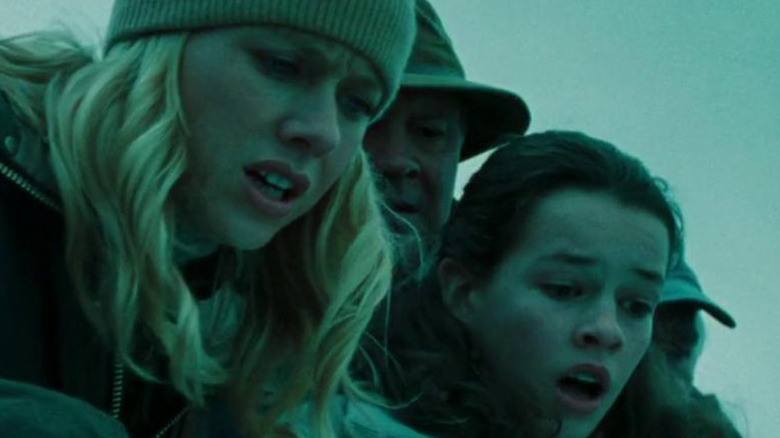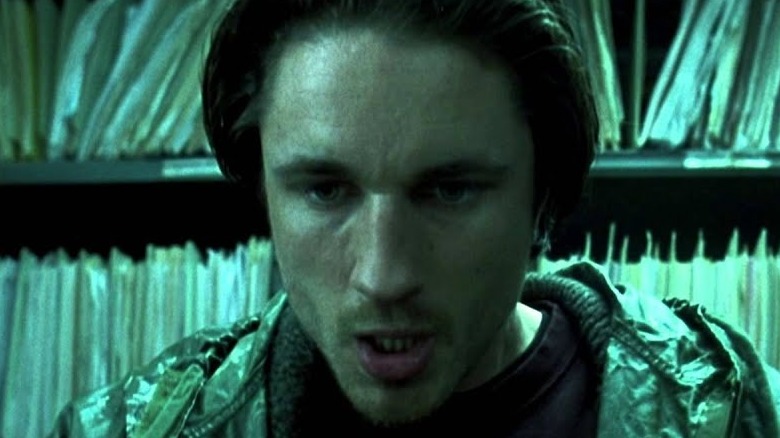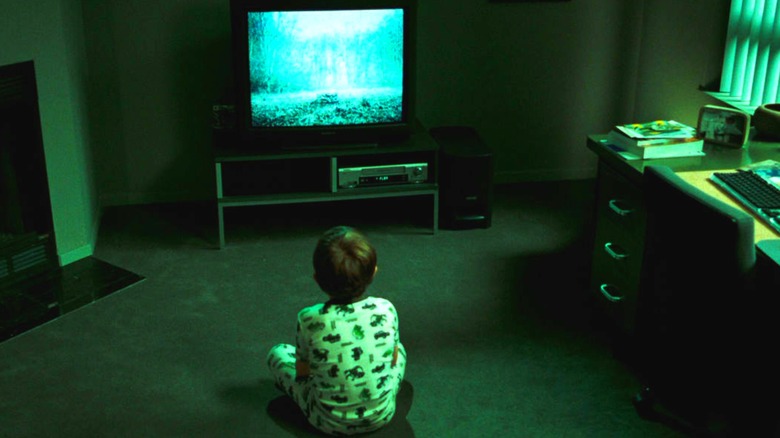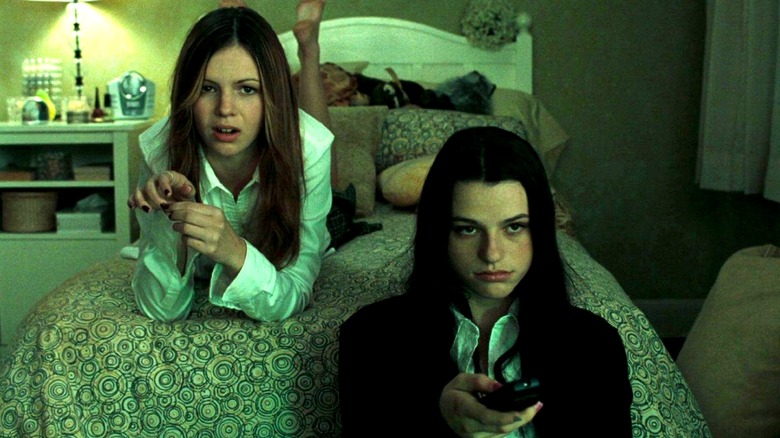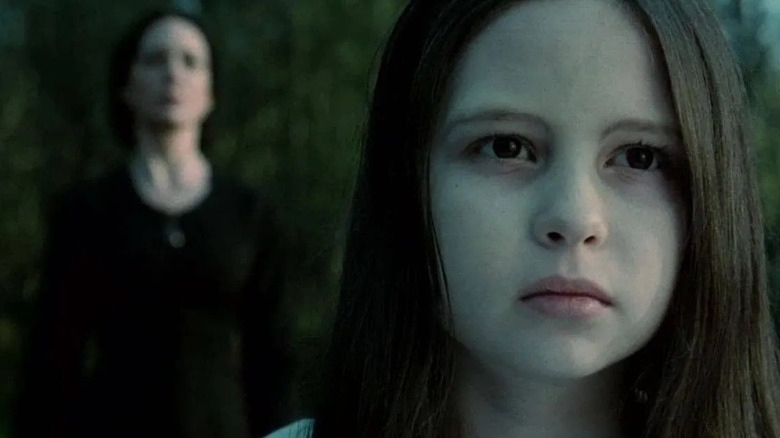The Untold Truth Of The Ring
The beginning of the 21st century kicked off a craze of American remakes of Japanese horror films. "The Grudge" and "One Missed Call" had their moment, but the biggest standout was unquestionably "The Ring." Starring Naomi Watts as Rachel Keller, a journalist trying to figure out the mysterious cause of her niece's death, the film has cemented itself as one of the scariest films of the new millennium. It's hard to beat the combination of supernatural terror and relatable normalcy you get with a story about a cursed videotape and a creepy phone call.
The film follows Rachel on this journey, taking her on an adventure that's just as twisted as the imagery on the haunted tape. When her young son accidentally watches the video, Rachel's investigation becomes a race against the clock, with seven days to unravel the mystery of the nightmare VHS before the entity that created it comes to claim them both.
Much like the video's surreal images, there's more to "The Ring" than meets the eye. Grab a flashlight — you never know where Samara could lead you — as we take you deep into the well and uncover everything you may not know about the movie.
The films are based on a book
"The Ring" is an American remake of the 1998 Japanese film "Ring," aka "Ringu," but even that isn't where its story begins. The Japanese film is based on a book of the same name published in 1991. Written by Koji Suzuki, it follows reporter Kazuyuki Asakawa as he investigates the mysterious death of his nephew and three other teens. While the American film has a similar plot, the characters are much different. Rachel receives help from Noah, the father of her child, whereas Asakaw has help from a friend. Both sets of characters have the same motivation to solve the mystery behind the tapes: their child sees it and they want to save their life.
The book is the first in a series. "The Ring 2" does not take inspiration from the second book, though the most recent American installment "Rings" does incorporate parts of the plot. What began as a trilogy eventually became five books and a collection of short stories. "Spiral," the second book, follows the Ring Virus, which is believed to cause tumors in its victims. From there, the books introduce a supercomputer called LOOP, a supernatural cancer, and another cursed video.
Even the book is an adaptation
While the films are based on the book, the book is inspired by a much older Japanese tale about a vengeful ghost. According to legend (chronicled by Yokai.com), Okiku was a servant working at the Himeji Castle who was killed and dropped down a well after she refused to be with a samurai named Aoyama. The samurai regularly tried to seduce Okiku as she continued to refuse his advances. He thought he could trick her into becoming his mistress by hiding a plate of food and framing her for its disappearance, saying he could overlook it if she would be with him. When she still rejected him, he could not contain his rage and tortured her.
After her death in the well, her ghost haunted the castle. She would walk the grounds at night, trying to find the dish Aoyama hid. She counted the dishes every night, up through nine, and when she couldn't find the tenth she would scream. People who heard her counting could become sick or even die if they heard her utter "nine." Eventually, she left the castle after a priest finished counting for her, making her think the final dish had been found.
There are some elements that clearly make an appearance in the film: the well, the counting (days, in this case), and the threat that something will happen to you at the end of the count. The real-life well that features in the story is still present on the castle grounds (via iHorror.com).
There were several films before the American version
The American version of "The Ring" isn't the first movie based on the story — in fact, it isn't even the second. The first film inspired by Koji's work was a 1995 Japanese TV movie released to video under the title "Ring: Kanzenban," though it initially premiered on television as simply "Ring." There are actually two versions of this movie, according to the fansite Curse of the Ring, which is why it was given a slightly different title for its home video release. The video version has some reshot scenes and restores some moments that were censored for its broadcast debut.
In 1998, another Japanese adaptation was released to the big screen. Also titled "Ring," this version made the pivotal switch from a male main character to a female main character, specifically that of a wife and her estranged husband. This is the version that laid the most groundwork for the American remake, with the idea of a female protagonist carried over to the American series.
Just a year later, a Korean adaptation of the book, "The Ring Virus," was released. Technically, this film was a joint Korean-Japanese production. It keeps with the changes of the Japanese theatrical feature and even seems to lift shots directly from it, which, according to Curse of the Ring, has caused debate among fans on which film was actually made first, as the timeline from production to release remains unclear.
The director wanted fresh faces in the leading roles
Director Gore Verbinski was adamant that he didn't want any A-list stars for his version of "The Ring." He hoped to avoid any overwhelming familiarity with the cast, which believed would distract from the horror of the story. "These movies work best without a marquee star," the filmmaker told Entertainment Weekly. "But there is a knee-jerk response from a studio, because [they're] spending money, to go out and get somebody." Fortunately, producer Walter F. Parkes was on Verbinski's side. "You don't go for the star, you go for the actress," Parkes explained in a promotional interview (via the YouTube channel vissouls).
Though she had just had her breakout role in David Lynch's "Mulholland Drive" shortly before "The Ring" went into production, Naomi Watts was still not a marquee name to mainstream audiences — something that worked in her favor in landing the part of Rachel. Verbinski went on to explain why Watts was the right choice. "She was perfect because she seduces us slowly," he said. "Suddenly she's there and we're in the same environment she is ... suffering the same delusions she is."
There were several actresses in line for the lead
While she may have been the perfect choice for the role, Naomi Watts was not the first in line to play Rachel. Verbinski knew he wanted relatively unknown actors, but studios like to have big names attached to projects, so some more prominent stars were considered before Watts was given the role.
A 2002 article from Entertainment Weekly revealed three other actresses who were up for the job. Gwyneth Paltrow, having recently won an Oscar for "Shakespeare in Love," was initially a contender, but at some point her name was removed from the mix. Jennifer Connelly ("Top Gun: Maverick," "A Beautiful Mind") read the script, but she reportedly requested changes to the script that would have modified the "moral ambiguities" she saw in the film. In particular, she was concerned over Rachel being characterized as an absentminded mother. According to the article, producers were unwilling to budge on the character as presented, and moved on from Connelly.
This led them to their top two choices: Kate Beckinsale and Naomi Watts. At the time, "Mulholland Drive" was receiving positive reactions on the festival circuit, garnering Watts some serious attention within the industry. It didn't take long for Verbinski to extend an offer, though Watts would later reveal her agent needed to talk her into taking on another psychological thriller.
Verbinkski predicted Martin Henderson's success in Hollywood
Watts wasn't the only fresh face the filmmakers found. Though well-known for his work in New Zealand, Martin Henderson, who portrays Rachel's ex-boyfriend and father of Aidan (David Dorfman), had yet to have a big break in American media. "It's wonderful to see somebody of that age and still be a new face," Verbinski commented during the aforementioned promotional interviews.
Henderson was 28 years old when "The Ring" was released, and just as Verbinski predicted, he's since gone on to make a name for himself. He held a leading role for three seasons on "Grey's Anatomy" as Dr. Nathan Riggs, a surgeon who once worked for the military. He's also one of the leads on the popular Netflix series "Virgin River." As Jack Sheridan, owner of the bar in the titular sleepy California town, he has survived a stabbing and found the love of his life. These roles have certainly elevated his status in the public eye, making him a familiar face to many.
Not only did the filmmakers find a promising newcomer in Henderson, they'd also found a great partnership in their two leads. "His natural exuberance and charm is a great counterbalance to the intensity of Naomi," Parkes enthused at the time. "And the two of them work together fantastic."
The film began production without a finished script
In an archived interview from 2002 (via Curse of the Ring), Verbinski spoke about the challenges "The Ring" presented during shooting. "The film went into production without a locked script," he shared. "It just makes everything insane." Going into production without a finished script certainly poses a challenge, especially if a scene were to be rewritten after it was filmed. The almost-final version of the screenplay involved three different attempts by writer Ehren Kruger, known for his work on the "Transformers" franchise and "Top Gun: Maverick." "We worked together very well," Verbinski noted.
During filming, Scott Frank ("The Queen's Gambit") was brought on to "polish" the screenplay. "I admire Scott's writing," the director stated. "But we had very little contact as I was shooting by this time." Verbinski went on to reveal that much of the visual information was absent from the screenplay, explaining, "It just wouldn't read as well as it appeared." By his own admission, he used a notebook throughout the shoot to improvise much of the look of the film.
A serial killer was cut from the film
As with most films, some significant scenes were shot for "The Ring" that never made it to the final cut. In this case, an entire storyline was left on the cutting room floor after the test screenings. Based on quotes from a Sci-Fi Wire interview archived by Moviehole, Chris Cooper filmed a handful of scenes that would have run throughout the film, but his character didn't make it to the screen at all. In these scenes, Cooper would have portrayed a serial killer trying to get on Rachel Keller's good side, attempting to harass her into clearing his name via her investigative reporting. But she knows he's guilty, and when the end of the film finds her needing to show someone a copy of the tape to pass on Samara's curse, he makes the perfect recipient.
"What I hear is when they ran the screenings, it was more a disruption than anything," Cooper said in the interview. "They said, 'Well, where's Cooper? We want to see more of him.' So they cut it all." Essentially, it seems his role was prominent enough to be distracting, without being important enough to devote more screentime to. Rather than rework his scenes, his work was cut from the film before it hit theaters. In the final cut, we have no way of knowing just who will fall victim to Rachel's copy of the tape and allow Aidan to survive.
A number of horses were needed for that iconic scene
Horses are a common theme in "The Ring," as we learn that Samara was kept in her family's stables, leading to their appearance among the imagery on the tape. In one of the film's most disturbing sequences, Rachel is riding a ferry when a horse goes berserk, breaks free, and leaps to its death in the water. Watching this terrifyingly powerful animal run wild is enough to make one wonder how the scene was shot.
According to Humane Hollywood, eight different trained stunt horses were used. Each one was trained to do a different part of the scene, from jumping to turning to rearing up. To simulate the horse diving off the ferry and into the water, a horse jumping over a rail was filmed in front of a green screen and combined with a computer-generated jump during post-production. Live horses were also used in shooting the photos of a woman on horseback, found by Rachel as she researches Samara's origins.
In addition to the ferry scene, there's the imagery of dead horses on a beach. This portion of the cursed videotape was accomplished with actual horses, though they weren't alive for the shoot. The production team bought and posed taxidermy horses on the beach as needed, achieving the perfect nightmarish effect.
The Ring took marketing inspiration from The Blair Witch Project
Horror fans may be familiar with the 1999 viral marketing campaign behind "The Blair Witch Project," which involved websites and missing posters, as well as a mockumentary that aired on the Sci-Fi Channel. It successfully convinced some people that what they were seeing on screen was real footage. In ramping up hype for "The Ring," DreamWorks decided to take a leaf out of the "Blair Witch" book.
As fans once discussed on the forum Quarter to Three, there are stories of people finding unmarked VHS tapes that had the "cursed video" from the film. Some found them outside their doors, while others found it on the windshield of their car after a concert. While these stories haven't been verified outside of anecdotes, it certainly is a great way to market a film. "You're hitting your target audience smack dab in the middle of their bored, adolescent faces," Emily Kaye Lazzaro wrote for The Hairpin. "My friends and I all went to see 'The Ring' when it came out, so I guess it worked!"
Creepy Catalog reports that the only information these tapes gave their finders was a website URL. The site, anopenletter.com, says what will happen after watching the video and links to another website, sadakoisdead.com. (Sadako is the name of the ghost who created the tape in the book, which was changed to Samara for the American film.) The site also contained additional videos, though those have been lost to time.
This marketing carried over to 2005's sequel "The Ring 2" as well, with the website 7daysleft.com set up so fans could scare their friends. All they had to do was submit an email address and phone number — the site would then send an email with the video, and a call would come through, with Samara's voice whispering just like in the movies (via NetImperative).
But the television marketing needed some work
While leaving unmarked VHS tapes around town worked well to build hype, the television spots for "The Ring" were missing the mark. The original spots featured the iconic ring with the text "Before you die, you see the ring" (via the Los Angeles Times). After underfilled test screenings, averaging 60% to 70% full, the team decided to make some changes to the ad spots.
Adding in audience reactions and the well that's so prominent in the film seemed to do the trick, despite DreamWorks releasing "The Ring" in fewer theaters than initially planned. Within a month of its release, it broke the $100 million mark and spread like wildfire. A successful opening weekend, which brought in $4 million more than anticipated, resulted in more theaters picking up the film, eventually showing in 2,900 theaters by its fourth week. The movie's success only grew from there, with teens and young adults turning out in droves as positive word of mouth spread like Samara's curse.
How The Ring ended up with a PG-13 rating
The intended audience of "The Ring" was always teenagers (even if they didn't come to the test screenings), and they needed to be able to buy tickets and get scared with their friends, not relying on their parents to see it with them. That meant the film couldn't be rated R, as it would alienate most of the crowd that DreamWorks hoped would be eager to see it. In order to drop the rating down a notch from what would have been an R, a certain amount of gore had to be removed. Exactly how much was trimmed isn't known for sure, though Creepy Catalog speculates that the videos available on sadakoisdead.com came from cut scenes.
"You shouldn't underestimate the importance of the PG-13 rating," Terry Press, then marketing chief of DreamWorks, told the Los Angeles Times. "Teens can't believe they get to go to a scary movie unaccompanied by their parents." Producer Parkes noted that the changes made to allow for the lower rating made the project more comparable to movies like "The Sixth Sense" instead of the slashers like "Scream" that were popular at the time, setting it apart in the horror movie landscape.
Why Verbinkski thought The Ring would be a hard sell to western audiences
"The Ring" ends on a note of uncertainty, as Rachel realizes Aiden will have to make a copy of the cursed tape in order to survive, saving his life but passing on Samara's curse in what may be a never-ending chain of horror. "The western desire for linearity, and resolution are so destructive to a film like this," Verbinski shared with Curse of the Ring. "It's hard to fight against that and still keep the audience interested." To combat this, he took a "breadcrumb approach," dropping little hints about the story until the end, ensuring the audience kept trying to guess what the resolution would be.
"The only resolution in life is death, and I believe that we seek out resolution in stories as a response to this," the director commented. "So we tried to use this in conjunction with the tape to create the feeling of a resolution — yet at a price: What would you do to save your child?"
There were some changes made between the remake and the original 1998 film, specifically in the evil that is Samara. "I also tried to emphasize the viral essence of [Samara's] evil ... How it moves from victim to victim," Verbinski explained. "I like how it attaches itself, that it feeds on an essentially human attribute as a means of infection: ultimately it is our own curiosity that propels it."
